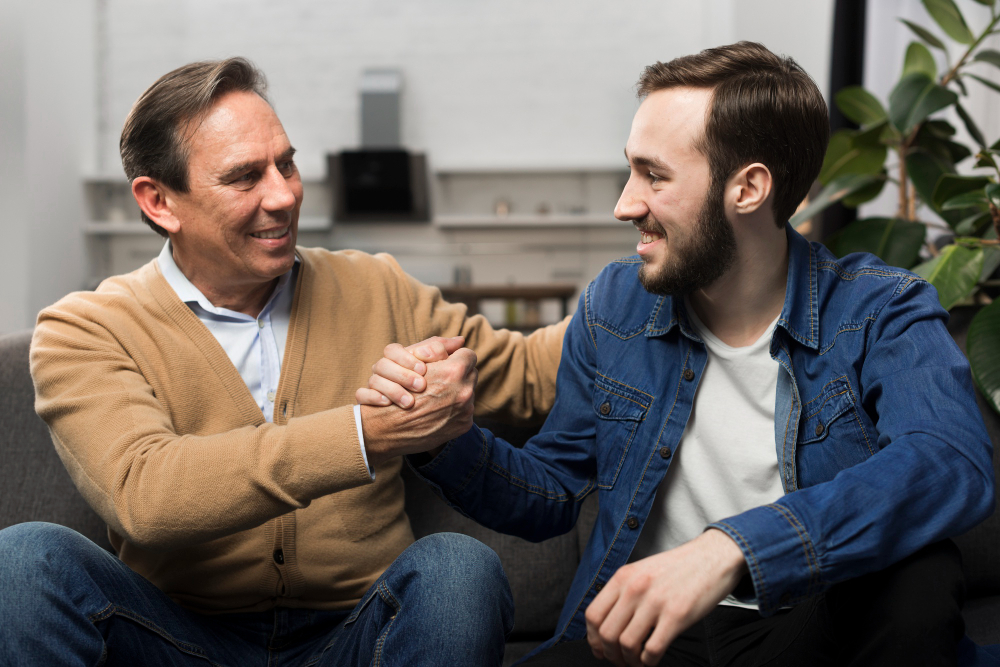Recovery doesn’t begin with perfection—it starts with a decision. If you’re exploring Forward Health’s sober living programs in Columbus, OH, you’ve already taken one of the most important steps: seeking a better future. We’re here to meet you at this turning point with guidance, structure, and genuine care.
Our sober living program offers more than just a place to stay—it’s a space to grow, heal, and rebuild. With personalized support, a focus on long-term sobriety, and access to ongoing outpatient treatment, we help you reintegrate into daily life while staying grounded in your recovery.
This chapter of your journey is about progress, not perfection. With Forward Health beside you, you can move forward confidently—toward stability, independence, and a life free from addiction.
What is a Sober Living Program and How Does it Work?
Sober living programs offer a crucial transitional space for individuals in recovery. They provide safe, structured environments where you can refine your sobriety while continuing treatment. These programs differ from detox, inpatient rehab, and outpatient care by focusing on day-to-day living in a supportive environment.
A Vital Step Between Treatment and Independence
Sober living serves as a vital bridge from intensive care to independent living. It fosters responsibility through daily routines, curfews, and communal living. Community support strengthens your commitment to recovery. Accountability emerges as you navigate life with peers who share similar goals, reducing feelings of isolation. In a sober living program, the emphasis on structure and peer interaction promotes a smoother transition to everyday responsibilities and independence.
Forward Health Offers IOP with a Sober Living Component
Forward Health Ohio offers Intensive Outpatient Programs (IOP) that integrate with a sober living environment, providing you with the structure and support essential for recovery. While we specialize in outpatient care, we understand the importance of a stable living situation and help you access supportive housing when your home environment isn’t conducive to your recovery journey.
Benefits of IOP with Sober Living
Combining IOP with a sober living component enhances several aspects of your recovery, including:
- Increased Accountability: Living in a sober environment with peers reinforces your commitment to sobriety and helps you adhere to the goals of your IOP.
- Peer Support: Engaging with others in recovery fosters a sense of community, making you feel less isolated and more understood as you navigate your journey.
- Reinforced Daily Routines: Structured living arrangements encourage you to establish healthy habits, including regular attendance at therapy sessions and participation in recovery meetings.
Levels of Care
For more information on related services, consider exploring our dedicated pages:
- Partial Hospitalization Program (PHP): Provides daytime structure with evenings spent in sober housing or at home.
- Intensive Outpatient Program (IOP): Weekly therapy sessions, 3 to 5 days, with the choice of supportive housing for added recovery stability.
- Outpatient Program (OP): A flexible step-down program designed to help you reintegrate into daily life with minimal clinical hours.

Benefits of a Sober Living Program for Addiction Treatment
Sober living programs in Columbus provide critical support that facilitates recovery and fosters long-term sobriety. These programs serve as essential transitional environments for individuals in recovery, bringing several key advantages to their journey.
Accountability and Peer Support
Living among peers in a sober living home creates a strong connection that reduces feelings of isolation. You benefit from shared experiences and camaraderie, which enhances your commitment to sobriety. Structured environments often include rules like curfews and mandatory meetings, fostering accountability among residents. Regular interactions with others on similar paths provide encouragement and motivate continued recovery efforts.
Rebuilding Routines and Responsibilities
Sober living environments help you regain structure in your daily life. Programs incorporate daily chores, scheduled meetings, and job support, instilling a sense of responsibility. Living in a structured setting allows you to practice essential life skills, such as managing time and fulfilling obligations. These routines not only aid in adjusting back to everyday life but also reinforce healthy habits necessary for lasting sobriety.
Lower Relapse Rates and Better Outcomes
Research indicates that individuals participating in sober living programs experience lower relapse rates compared to those who transition directly to independent living from intensive treatment. The supportive community and access to local resources enhance overall recovery outcomes. Engaging in a sober living program leads to a higher likelihood of maintaining long-term sobriety, providing the stability and encouragement you need on your path to recovery.
Support Services and Therapies Available Through Forward Health Ohio
Forward Health Ohio offers a range of support services and therapeutic options that enhance your experience in a sober living environment. These services aim to bolster your recovery journey, blending community support with professional guidance.
Integrated Therapies
- Individual Therapy: One-on-one sessions with licensed counselors target trauma and mental health, offering personalized support tailored to your needs.
- Group Therapy: Engage in peer-driven discussions that foster shared learning and emotional support. This setting encourages connection and understanding among residents.
- Telehealth Options: Access therapy remotely for added convenience, especially beneficial when transitioning from sober living to home.
- Employment Support & Financial Skills Coaching: Learn vital life skills to regain independence, enhancing your ability to find employment and manage finances.
- Dual Diagnosis Treatment: Receive mental health services for co-occurring disorders, ensuring a comprehensive approach to your recovery.
These therapies and services create a structured framework, empowering you to build a solid foundation for long-term sobriety.

Why Choose Forward Health Ohio for a Sober Living Program in Columbus, OH?
Forward Health Ohio offers unique advantages for those seeking a sober living program in Columbus. Our focus on individualized care creates a supportive environment that enhances recovery.
Bulleted List of Key Reasons to Choose Forward Health
- Experienced Staff: Our team comprises professionals with lived experience in recovery who understand your journey.
- Comprehensive Care Options: Access to Partial Hospitalization Programs (PHP), Intensive Outpatient Programs (IOP), and Outpatient Programs (OP) ensures a smooth step-down process.
- Integrated Support Services: We provide employment and financial skills coaching to aid in your independence.
- Personalized Treatment Plans: Each plan focuses on your long-term sobriety and adapting to life beyond recovery.
- Local Partnerships: Collaborations with local sober living homes guarantee safe, supportive housing.
- Telehealth Access: Benefit from increased flexibility with convenient remote therapy options.
- Insurance Acceptance: We accept most Ohio Medicaid and insurance plans, making quality care accessible.
How to Get Started with a Sober Living Program in Columbus, OH
Getting started with a sober living program in Columbus is a straightforward process designed to support your recovery journey. With the right resources and assistance, you can access the guidance you need to transition successfully into a sober lifestyle.
Take the First Step Today
Start your path to recovery by contacting Forward Health Ohio. You can reach us by phone or through our online form, allowing you to get immediate assistance. Our intake process emphasizes confidentiality and compassion, ensuring you feel supported from the very first interaction. We’re available 24/7, so there’s no need to wait. Begin your personalized recovery journey today and set a solid foundation for long-term sobriety.
Frequently Asked Questions
What is a Sober Living Program?
A Sober Living Program is a structured, supportive housing environment for individuals recovering from addiction. It provides a safe space to help transition from intensive treatment to independent living while fostering accountability and community support.
How does Forward Health Ohio support individuals in recovery?
Forward Health Ohio offers a variety of services, including Intensive Outpatient Programs (IOP), individual and group therapy, and employment support. Their experienced staff and personalized treatment plans ensure comprehensive care tailored to each individual’s needs.
Why are sober living programs important?
Sober living programs are crucial because they offer a transitional space that helps individuals maintain their sobriety while rebuilding their daily routines and responsibilities. Evidence suggests that participants in these programs have lower relapse rates and better recovery outcomes.
What types of therapy are available in these programs?
Therapeutic options include individual therapy for personalized support, group therapy for peer connection, and dual diagnosis treatment for co-occurring disorders. These therapies provide essential frameworks for building a strong recovery foundation.
How does the intake process work at Forward Health Ohio?
The intake process at Forward Health Ohio is designed to be straightforward and compassionate. Interested individuals can contact them for immediate assistance, and their intake process is confidential, ensuring that support is easily accessible.
What are the benefits of living in a sober living environment?
Living in a sober environment fosters accountability, reduces feelings of isolation, and encourages the development of essential life skills. Residents often participate in daily chores and communal activities, helping them regain stability and responsibility.
How does telehealth fit into the sober living experience?
Telehealth options provide flexibility for individuals to access therapy and support remotely. This helps integrate professional care into the sober living experience, ensuring ongoing guidance and support as individuals transition to independent living.
Is Forward Health Ohio accepting of insurance plans?
Yes, Forward Health Ohio accepts most Ohio Medicaid and insurance plans. This makes their services more accessible for those seeking help and support in their recovery journey.
Can I receive support for employment while in a sober living program?
Absolutely! Forward Health Ohio offers employment support and financial skills coaching to help individuals regain independence and transition successfully into everyday life while in recovery.










